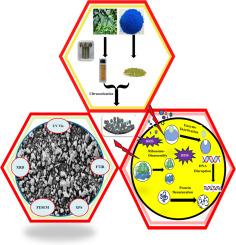碳点-氧化铜纳米复合材料的绿色合成:表征和抗菌研究
IF 5.7
3区 材料科学
Q2 MATERIALS SCIENCE, MULTIDISCIPLINARY
引用次数: 0
摘要
采用绿色合成技术制备了碳点氧化铜纳米复合材料(MHCD@CuO),该材料以密藤叶提取物为稳定还原剂。纳米复合材料的表征包括UV-Vis, XRD, SEM-EDX, FTIR和XPS。XRD的平均晶粒尺寸为28.3 nm, SEM显示出接近球形的纳米颗粒,具有少量的铅笔状结构(S1)。在XPS中发现了Cu、O、C和N,证实了参与稳定和生物活性的活性官能团的FTIR峰。采用孔扩散法测定MHCD@CuO对大肠杆菌、肠炎沙门氏菌、伤寒沙门氏菌、金黄色葡萄球菌、化脓性链球菌和黑曲霉的抑菌活性。对化脓性链球菌的MIC为15.62µg/mL(最敏感),对其他菌株的MIC为31.25µg/mL。这些结果突出MHCD@CuO作为有效的绿色抗菌候选药物,具有解决抗生素耐药性的潜力。本文章由计算机程序翻译,如有差异,请以英文原文为准。

Green synthesis of Carbon dot-Copper Oxide nanocomposite using Millingtonia Hortensis leaf extract: Characterization and antimicrobial studies
A green synthesis technique was used to produce a Carbon dot Copper Oxide (MHCD@CuO) nanocomposite using Millingtonia hortensis leaf extract as a stabilizing and reducing agent. Nanocomposite characterization involved UV-Vis, XRD, SEM-EDX, FTIR, and XPS. The average crystalline size from XRD is 28.3 nm, and SEM shows nearly spherical nanoparticles with few pencil-like forms (S1). Cu, O, C, and N were found in the XPS, corroborating the FTIR peaks of active functional groups involved in stabilization and bioactivity. The well-diffusion method was utilized to assess the antibacterial activity of MHCD@CuO against Escherichia coli, Salmonella enterica Typhimurium, Staphylococcus aureus, Streptococcus pyogenes, and Aspergillus niger. The inhibition zones were equivalent to reference antimicrobial For Streptococcus pyogenes, the MIC was 15.62 µg/mL (most susceptible), but for other bacterial strains, it was 31.25 µg/mL. These results highlight MHCD@CuO as potent and green antimicrobial candidate with potential in addressing antibiotic resistance.
求助全文
通过发布文献求助,成功后即可免费获取论文全文。
去求助
来源期刊

Materials Research Bulletin
工程技术-材料科学:综合
CiteScore
9.80
自引率
5.60%
发文量
372
审稿时长
42 days
期刊介绍:
Materials Research Bulletin is an international journal reporting high-impact research on processing-structure-property relationships in functional materials and nanomaterials with interesting electronic, magnetic, optical, thermal, mechanical or catalytic properties. Papers purely on thermodynamics or theoretical calculations (e.g., density functional theory) do not fall within the scope of the journal unless they also demonstrate a clear link to physical properties. Topics covered include functional materials (e.g., dielectrics, pyroelectrics, piezoelectrics, ferroelectrics, relaxors, thermoelectrics, etc.); electrochemistry and solid-state ionics (e.g., photovoltaics, batteries, sensors, and fuel cells); nanomaterials, graphene, and nanocomposites; luminescence and photocatalysis; crystal-structure and defect-structure analysis; novel electronics; non-crystalline solids; flexible electronics; protein-material interactions; and polymeric ion-exchange membranes.
 求助内容:
求助内容: 应助结果提醒方式:
应助结果提醒方式:


